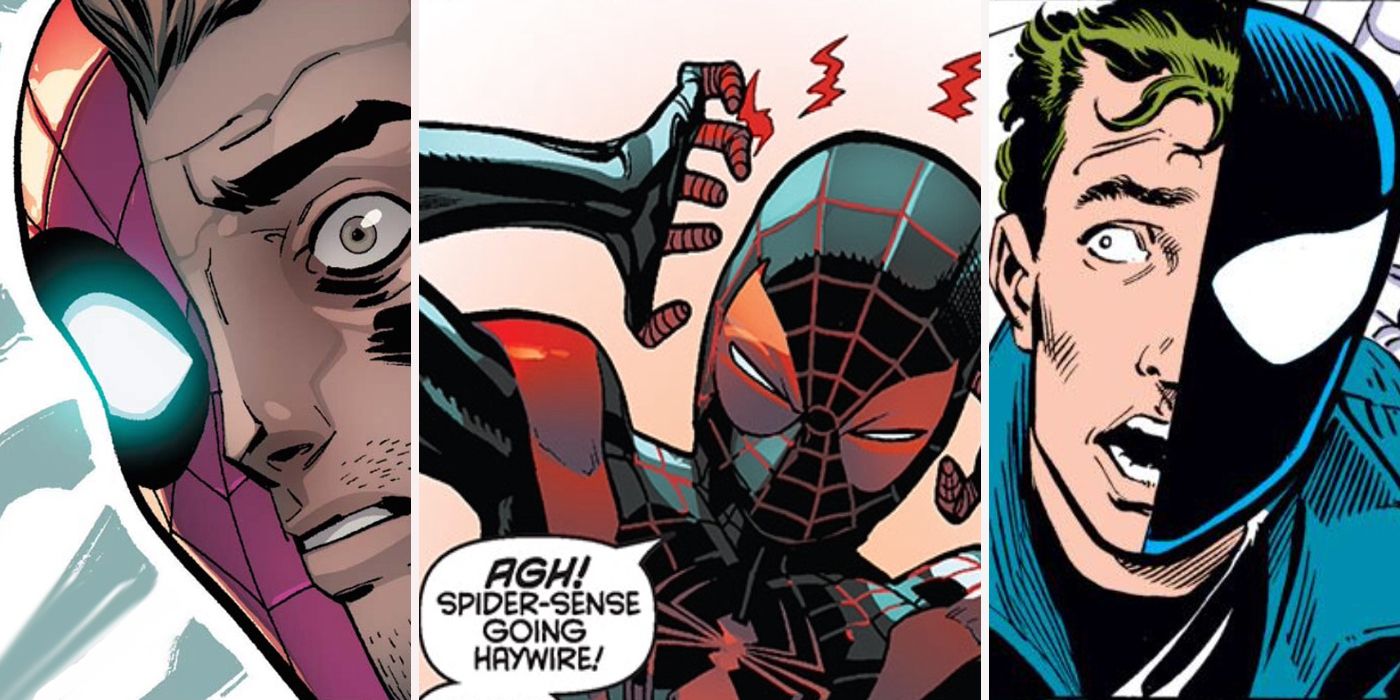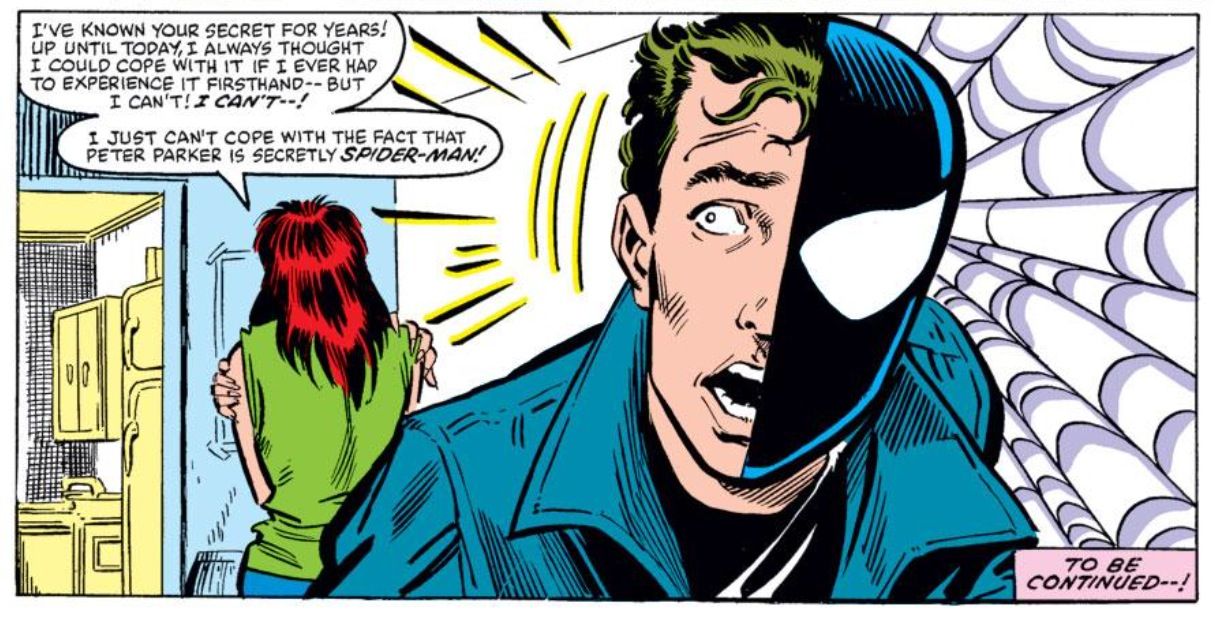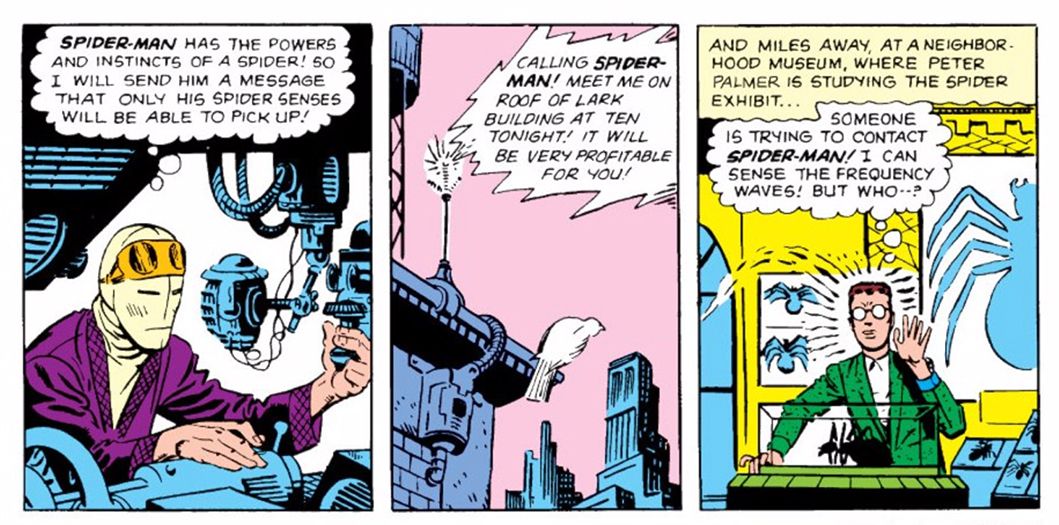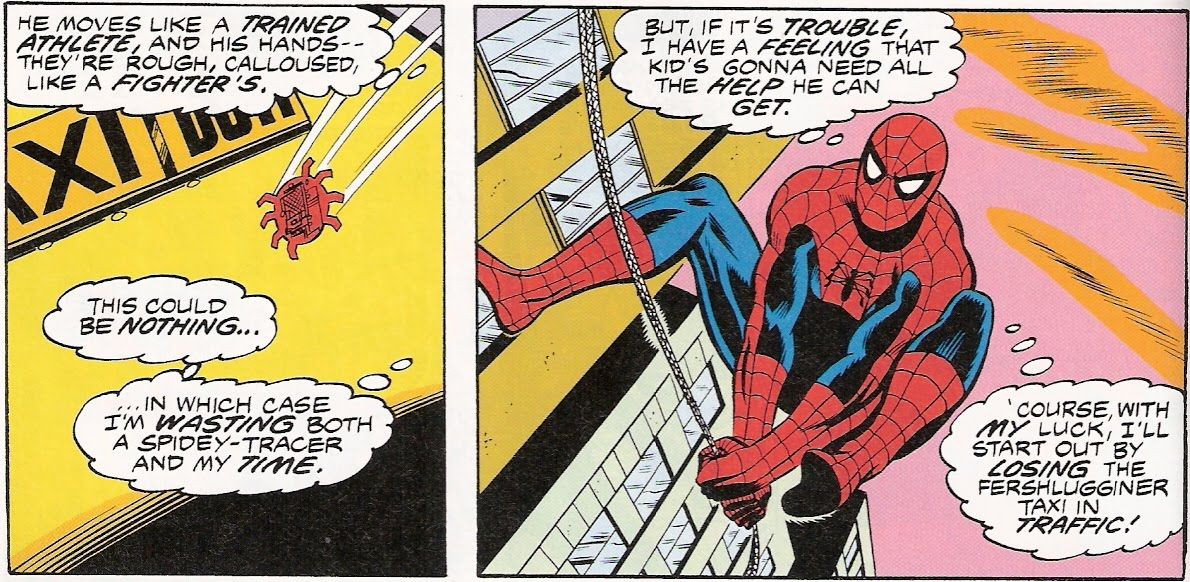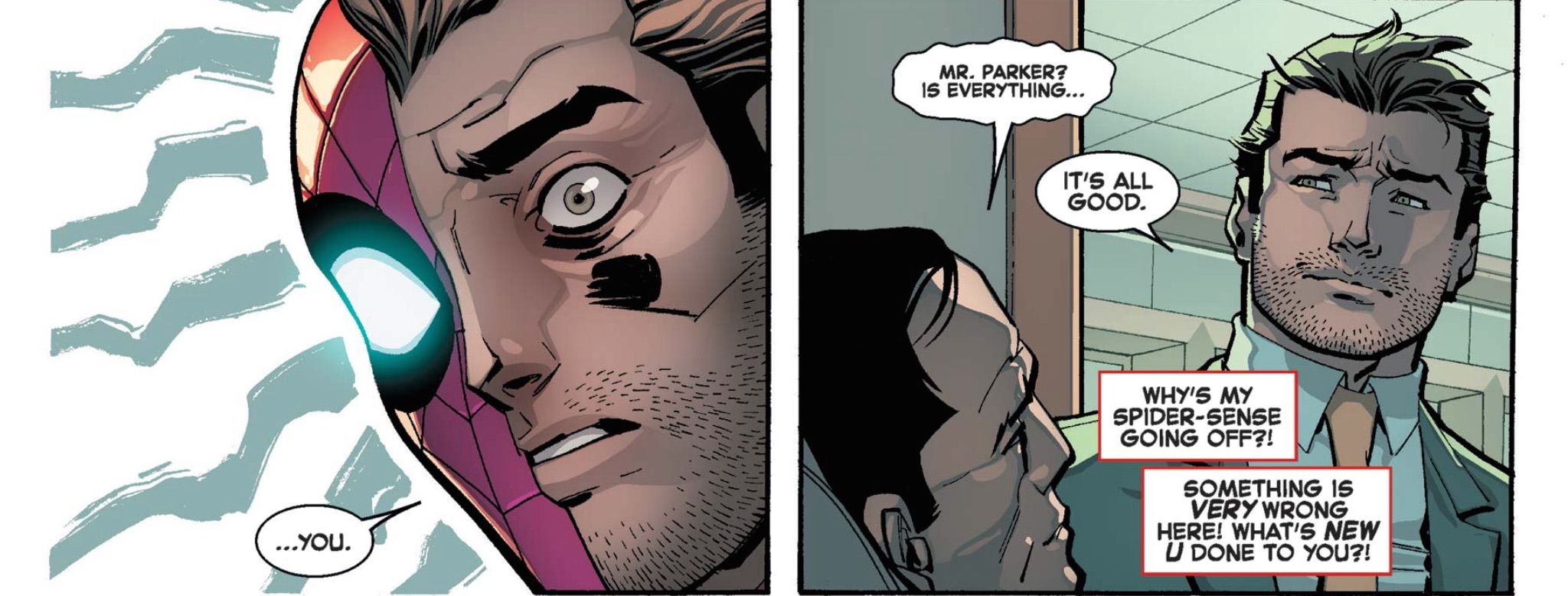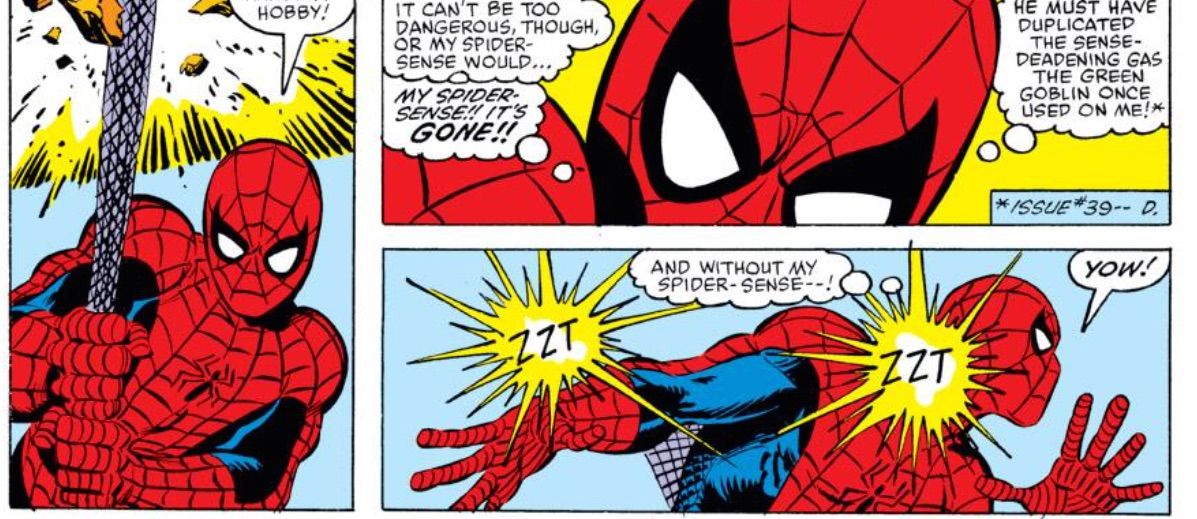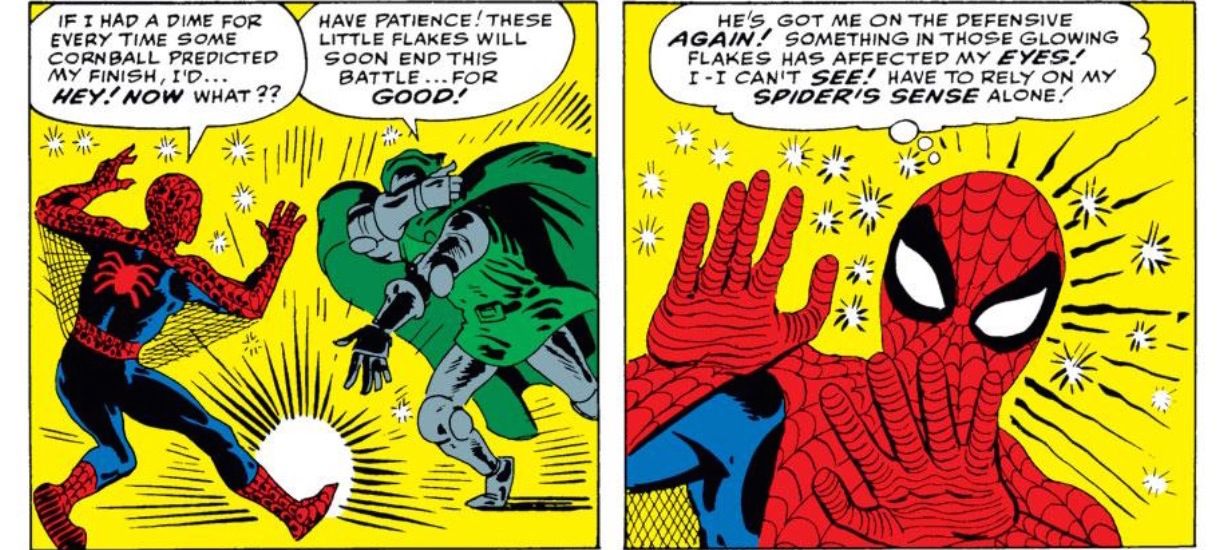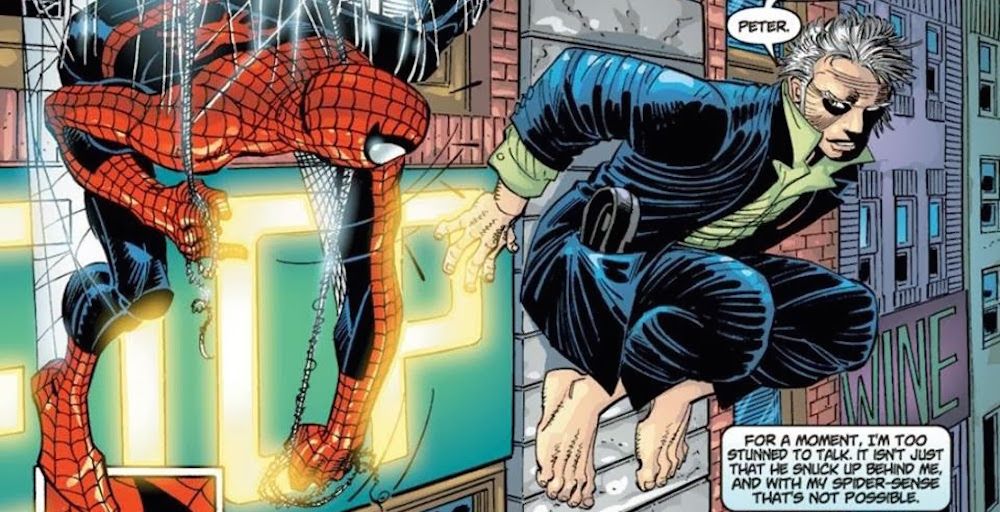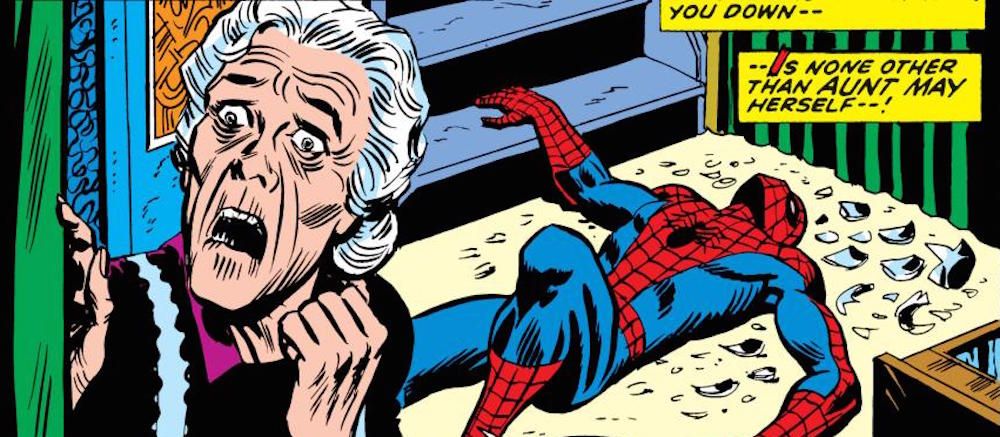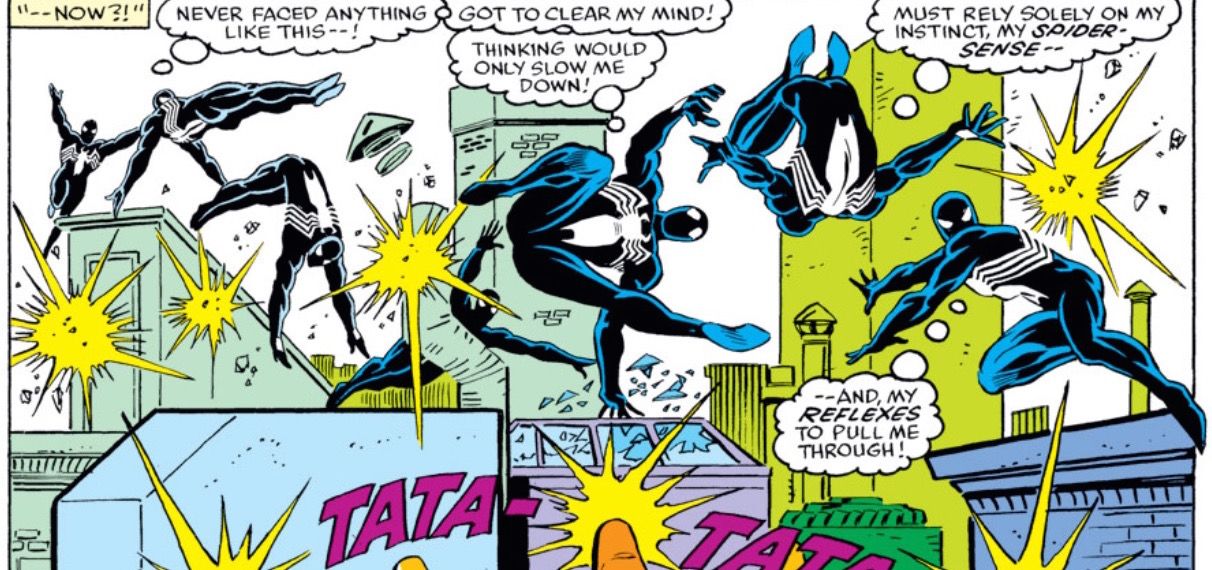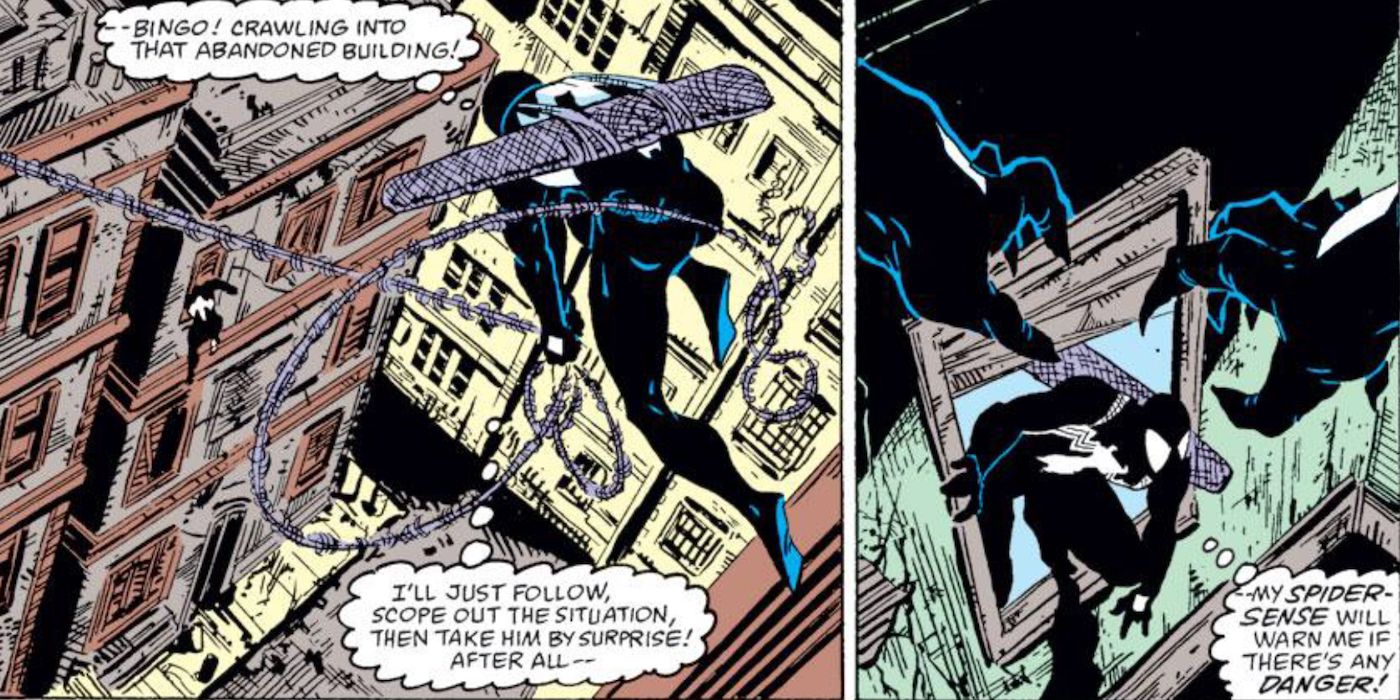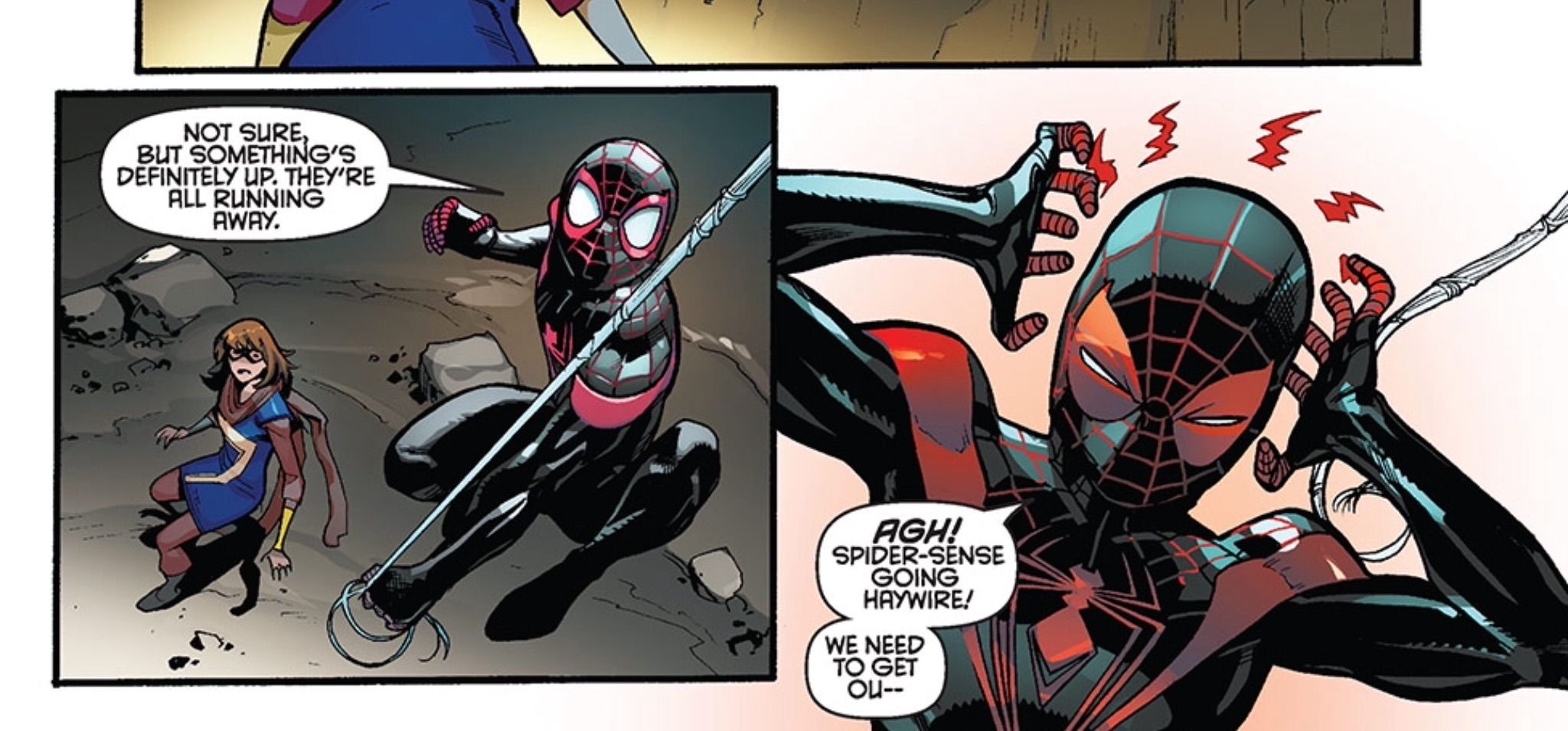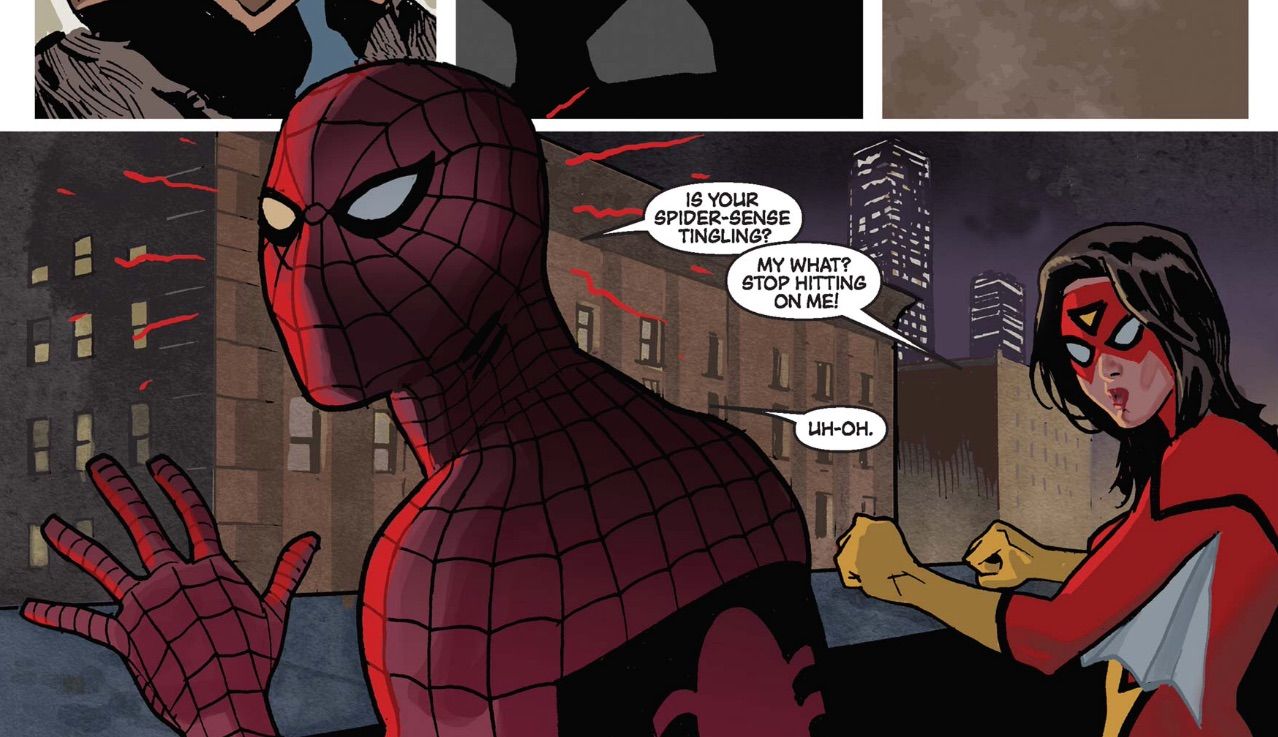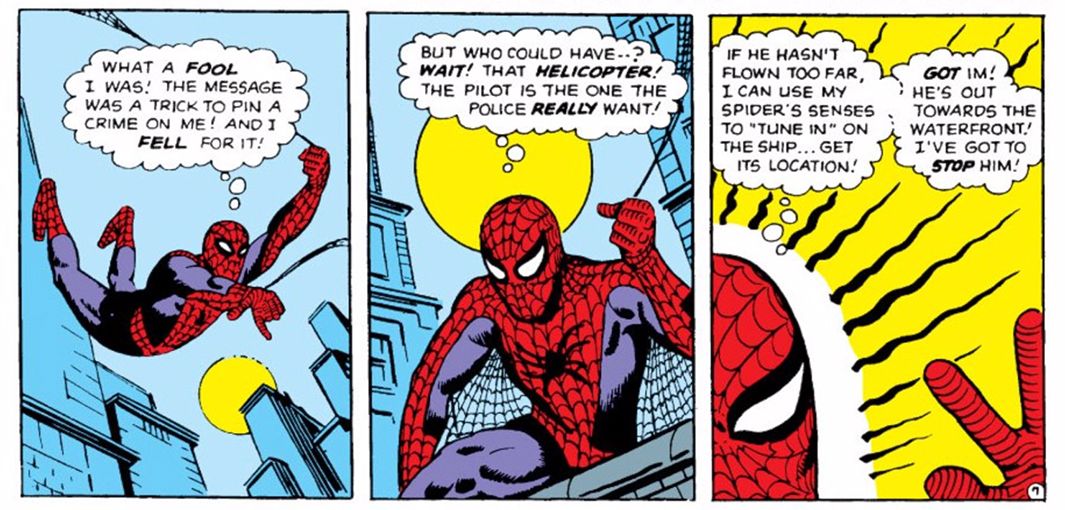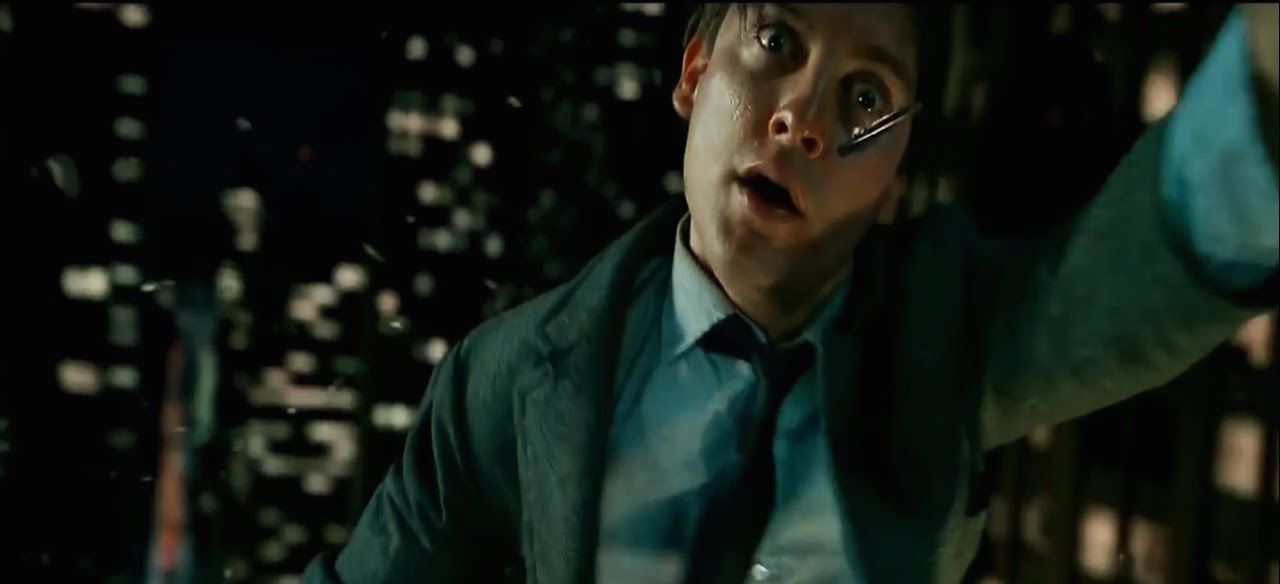Before the release of Spider-Man: Homecoming (2017), news broke that Peter Parker may not have one of his most iconic powers in the movie: his spider sense. Kevin Feige eventually confirmed that the MCU Spider-Man did in fact have his spider sense, it just wasn't explored specifically in the new film. That is a perfect example of why the power isn't just noteworthy, it's also confusing. It's one of the only super powers that can be appear in a movie and people aren't even sure if it's there or not.
RELATED: 15 Weaknesses You Never Knew The Hulk Had
The way that the power is supposed to work is like this: when there's danger nearby, Peter feels a buzzing in the back of his skull or top of his neck. He refers to this sensation as a tingling, which often sounds creepy to people who are unaware of what's happening. This power gives Peter a huge advantage in a fight and makes it nearly impossible for people to sneak up on him. Of course, given the confusing nature of the power, it gives writers a lot of freedom in how it's used. Over the years, it's become Spider-Man's most varied power, and here are 15 things people never knew about it!
15 IT ALWAYS LOOKS DIFFERENT
When Spider-Man shoots his web, he always makes the same hand motion. When he swings around the city or crawls around walls, there are certain poses that artists always draw him in. When spider sense activates, however, there's much less consistency. Initially, it was depicted as a bunch of wavy lines above his head. If it went off while he was walking around as Peter Parker, he would be drawn with a half Peter face, half Spider-Man face.
Meanwhile, over on-screen, The Spider-Man Animated Series (1994) would have the entire world turn into a mid '90s music video for a few seconds. In Sam Raimi's Spider-Man (2002), time would freeze and the camera would zoom around in bullet time. It seems like every artist or producer has their definition of what exactly it means to tingle.
14 DANGER DOESN'T HAVE TO BE IMMINENT TO ACTIVATE IT
Even though the ability to walk on walls and having super strength and agility are amazing powers, Peter's spider sense is definitely his best asset. While it's often referred to as a danger sense, it doesn't just detect imminent danger. As the Chameleon has often learned, the spider sense will warn Peter of dangerous people near him, even if they're currently not up to no good.
The problem with this is that with no imminent danger, Peter often doesn't realize why his spider sense is tingling. It lets him know that somebody around him isn't who they seem to be, like when Glory Grant briefly dated a werewolf. Peter ran into the couple in Amazing Spider-Man #316 (1989) by David Michelinie and Todd McFarlane, and Peter had no idea that his spider sense was buzzing to warn him to avoid the guy around full moons.
13 HE CAN COMMUNICATE WITH IT
In Amazing Spider-Man #1 (1963) by Stan Lee and Steve Ditko, the Chameleon makes his villainous debut. He hatches a plan to steal plans from a defense installation in New York City. Since he needs the real Spider-Man to show up at some point and take the fall, he uses a machine that broadcasts a message using a frequency that Spidey can pick up using his spider sense.
Spidey gets the message and shows up at the installation, not knowing that the Chameleon had just stolen the plans while dressed as Spider-Man. What's interesting is that Peter just starts hearing a voice in his head and decides to follow it. He never even questions how the Chameleon knew the exact frequency his most secretive power worked on. Peter really was pretty gullible during this time period.
12 IT CAN TRACK VILLAINS
Using his spider sense as the basis, Peter invented a way to track his enemies without them knowing in Amazing Spider-Man #11 (1964) by Stan Lee and Steve Ditko. He called the devices spider-tracers, and they're tiny little spider shaped transmitters that he can stick to an enemy. They're small enough to not be noticed, and they broadcast a signal that can be followed. Initially, he needed a receiver to follow the signal, but he eventually upgraded the devices to work with his spider sense.
The real question is why Peter would develop a device that every hero could benefit from, and then change it into something that only he can really use. Some other heroes like Daredevil can pick up the signal, but it doesn't work as well for them as it does for Spidey, who seems to be kind of selfish with his crime fighting equipment.
11 CLONE DETECTOR
If Peter encounters somebody who's evil, they'll usually activate his spider sense, even if they're currently not up to anything. Recently, however, it's also been revealed that his spider sense can detect clones. At least, that's what seemed to be suggested in Amazing Spider-Man #16 (2016) by Dan Slott and Giuseppe Camuncoli.
After an explosion at one of Parker Industry's plants, one of the workers was left dying from chemical wounds. Peter allowed a medical firm called New U to perform an experimental procedure to save the man's life. In reality, they just cloned the man and switched the two bodies. The clone wasn't aware it was a clone, so it didn't have any duplicitous intentions. However, Peter's spider sense seemingly just went off because it recognized that the guy was a clone and it knows that clones mean nothing good is about to happen.
10 HE LOSES IT ALL THE TIME
Out of all of Peter's super powers, it seems like his spider sense is the most fragile. All the way back in Amazing Spider-Man #39 (1966) by Stan Lee and John Romita, the Green Goblin developed a gas that could knock out Spidey's danger sense, allowing him to follow the hero around without Spidey having any idea. Unfortunately, Peter changes out of his Spider-Man costume with the Goblin watching, which would go on to have major ramifications for years to come.
This gas has been replicated several times by villains hoping to finally catch the hero by surprise without his spider sense warning him. It's a good thing that Peter's other powers can't be turned off so easily, or else his superhero career would've ended a long time ago.
9 IT'S NOTHING LIKE A REAL SPIDER
Out of all of Spider-Man's powers, his spider sense seems like the most random. Most species of spider can walk on walls, are comparatively strong for their size and are incredibly agile, so it makes sense for Peter to also have those powers. They also shoot webs, but Peter just replicates that power with mechanical web shooters. One thing spiders definitely don't have is a precognitive sense that warns them of danger.
The thing is, there are species of spiders that do have a sort of "danger sense." Some species can feel any sort of vibration on their web, while others are highly sensitive to changes in air pressure, warning them of any nearby intruders. Sadly, real spiders can't use their danger sense to tell when someone's lying, or a clone or secretly a supervillain.
8 IT MIGHT BE MYSTICAL
Part of the reason why Peter's spider sense is so much different than that of a normal spider is that it might actually be mystical in nature. In Amazing Spider-Man #30 (2001) by J. Michael Straczynski and John Romita Jr, Peter meets a man named Ezekiel, who has spider powers of his own. Ezekiel tells Peter that he didn't get powers from an irradiated spider, but had actually become a human totem and had formed a mystic link with spiders.
This would explain why Peter's spider sense acts the way that it does, as opposed to being more like a real spider's danger sense. Of course, the standing of the mystical aspect of Peter's origin has never been fully confirmed, but he has been the target of the villain Morlun, who feeds off of spider totems, so it seems that there is at least something slightly mystical about Spidey's powers.
7 IT CAN DIFFERENTIATE BETWEEN FRIEND OR FOE
While Peter's spider sense is usually pretty good at alerting him to danger, it has one major flaw: it can apparently tell the difference between a friend or foe. In Amazing Spider-Man #114 (1972) by Gerry Conway and John Romita, Spider-Man is spying on Doctor Octopus' hideout when he's suddenly struck in the back of the head with a vase. His spider sense didn't warn him because the assailant was his Aunt May.
Obviously, this is a huge flaw in the power. Luckily, it also doesn't seem to be very consistent. If that were the case, then any time Spider-Man fought another hero (which, in Marvel comics, is a surprisingly common occurrence), his spider sense wouldn't help at all. Thankfully, it only seems to be an issue when it's convenient for the writers.
6 IT SOMETIMES TAKES CONTROL
Peter's spider sense is so powerful that it can actually take control of his reactions for him. That makes sense, considering that it often warns him of dangers like bullets or laser beams or any other sort of crazy ray that's being shot at him. By the time the danger sense went off and Peter recognized it and decided to move out of the way, whatever was being shot at him would have already hit him.
Over the years, Peter's trained himself to just let his spider-sense take control, especially when he's in a fight. This allows him to avoid getting hit while also focusing on how take down whatever villain he's currently facing. Of course, this does come with one obvious downside.
5 IT DOESN'T WORK ON EVERYBODY
There are several people who don't activate Peter's spider sense, leaving him at a direct disadvantage during a fight. While some villains have figured out ways to temporarily deactivate the power, others are permanently immune to it for various reasons. That means when Peter faces off against them, he's fighting with a severe disadvantage.
For example, since Peter wore the Venom symbiote for an extended period of time, it's become completely invisible to the spider sense. When Spider-Man finally met Eddie Brock in Amazing Spider-Man #300 (1988) by David Michelinie and Todd McFarlane, he was surprised that Venom was able to keep catching him by surprise. Fortunately, it wasn't enough of an advantage and Peter was still able to beat the villain.
4 IT'S POWERFUL ENOUGH TO HURT
While having a danger sense is an obvious benefit, it has one major downside: when it triggers hard enough, it can actually hurt Spider-Man. A recent example of this actually occurred in Nova #4 (2016) by Sean Ryan and Corey Smith, albeit to Miles Morales and not Peter. Still, the two have very similar spider senses, considering they both got their powers from similarly mutated spiders.
During a fight in the Mole Man's underground lair, when Spidey's sense warned him about an imminent cave in, it clearly hurt him. If the danger is strong enough, the buzzing seems to be enough to cause pain. Granted, in the situations where it hurts Spider-Man, the spider sense becomes more of a distraction than a help.
3 NOT EVERYONE KNOWS IT EXISTS
Spider-Man is one of the Marvel Universe's most famous heroes, not just in the real world, but also in the world of Marvel. Everyone seems to know of him, but surprisingly, they're not all well-versed in his powers. Now, plenty of people are aware of Spidey's spider sense, but there's also a surprising number of people who seem to have no idea what Peter means when he says his "spider sense tingling."
In New Avengers #61 (2010) by Brian Bendis, Stuart Immonen and Daniel Acuna, Spider-Man is hanging out with Spider-Woman, and when he mentions his tingling spider sense, she has no idea what that means. Out of all people, Spider-Woman should know Spider-Man's powers, but apparently she's too busy to learn the powers of the other spider-people she knows.
2 HE CAN CONTROL IT
At first glance, it might seem like this is less of a superpower and more of an extra sense (hence why it's called spider sense). This would imply that it's like any other sense and it's just always working, regardless of what Peter wants. For example, he can't decide not to taste something or turn his ears off. While it's always ready to buzz for danger, Peter also has some level of control over it.
In Amazing Spider-Man #1 (1963) by Stan Lee and Steve Ditko, Peter was able to focus his spider sense to locate a helicopter the Chameleon was using to escape. Considering that Spider-Man had just been framed for a crime and was being chased by the cops, it's pretty astounding that he was able to tune out all of the other danger around him to locate a fleeing threat.
1 IT'S HIS MOST INCONSISTENT POWER
For the most part, writers all agree on how Peter's powers work. While there might be some debate as to how strong he is, or how sticky his wall crawling is (does he stick immediately, or could he slide down a building for a second?), they're generally depicted working the same way. The spider sense, on the other hand, is much more troublesome. It's the one power that writers seem willing to mold into their own uses, or sometimes even just straight up ignore.
In an early scene in Spider-Man 3 (2007), Harry Osborn is able to successfully pull off a sneak attack on Peter while he's driving down a New York City street. When asked about the spider-sense, the filmmakers basically admitted that they ignored it for story purposes. Basically, the spider sense works however the current writer needs it to work in that moment.
Would you want to have a spider sense, or would it be more of a burden than a gift? Let us know in the comments!

